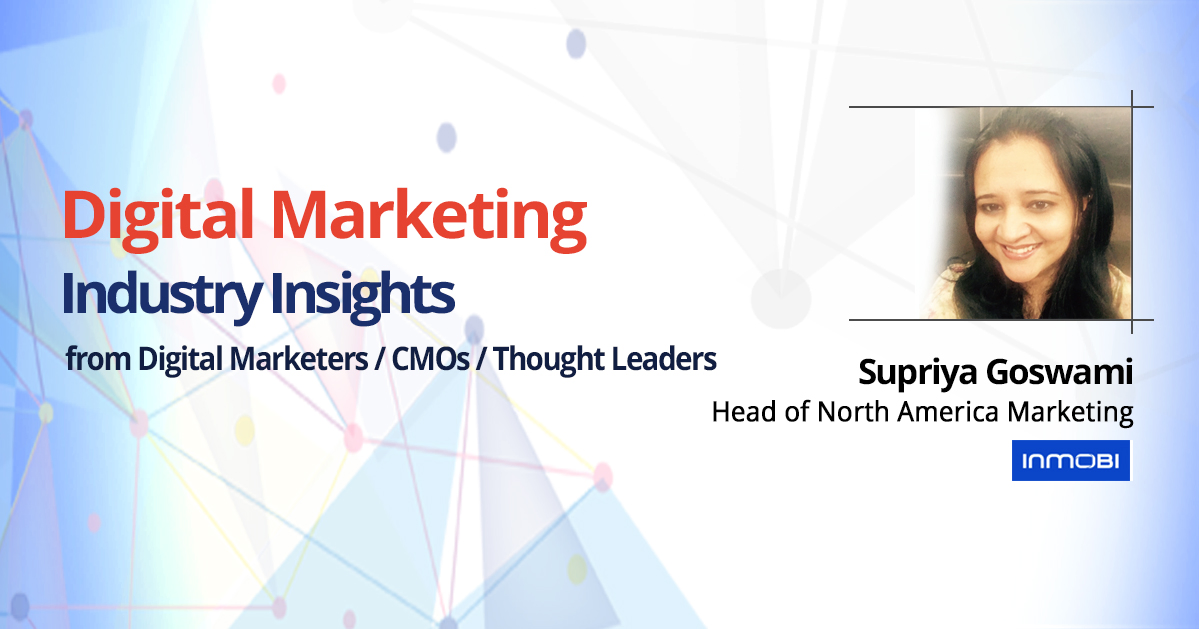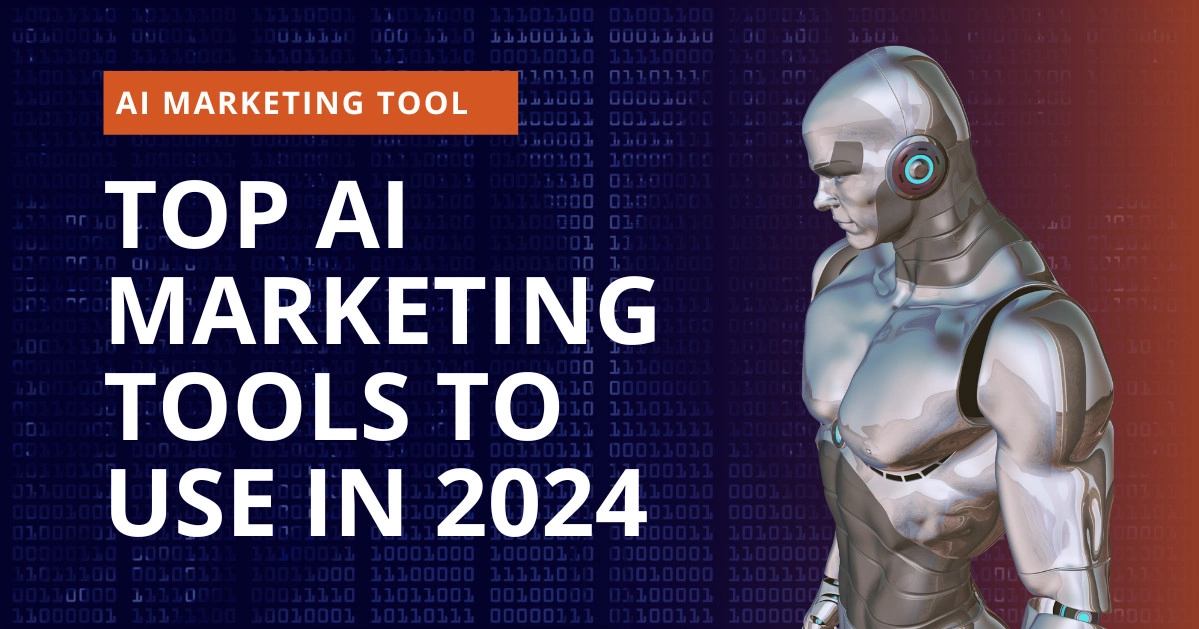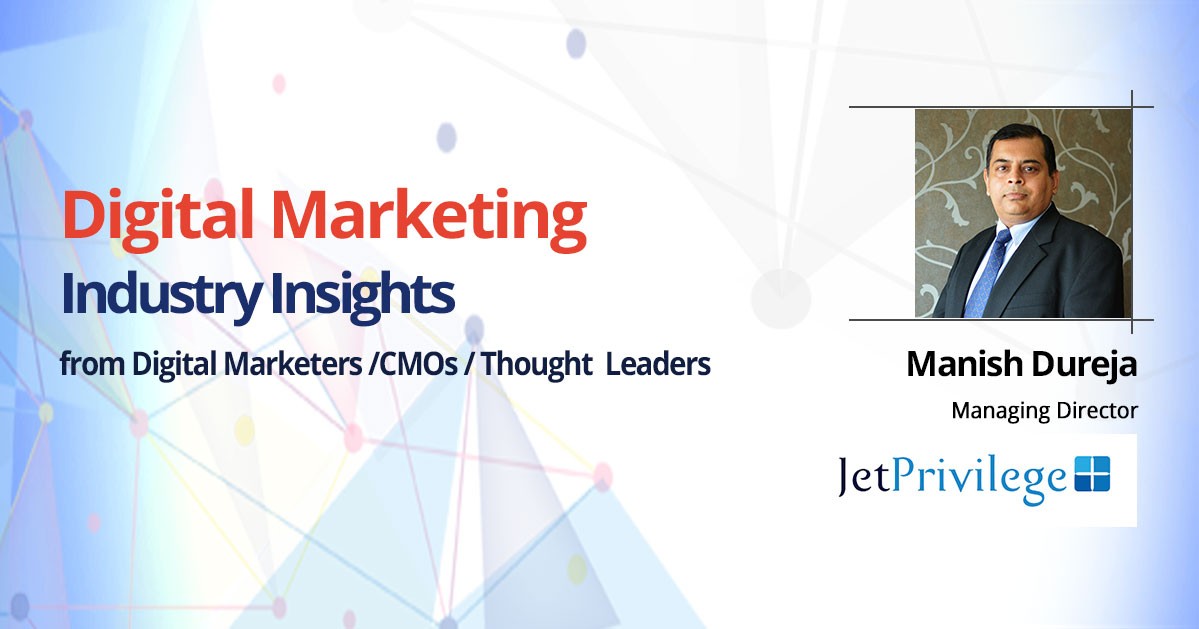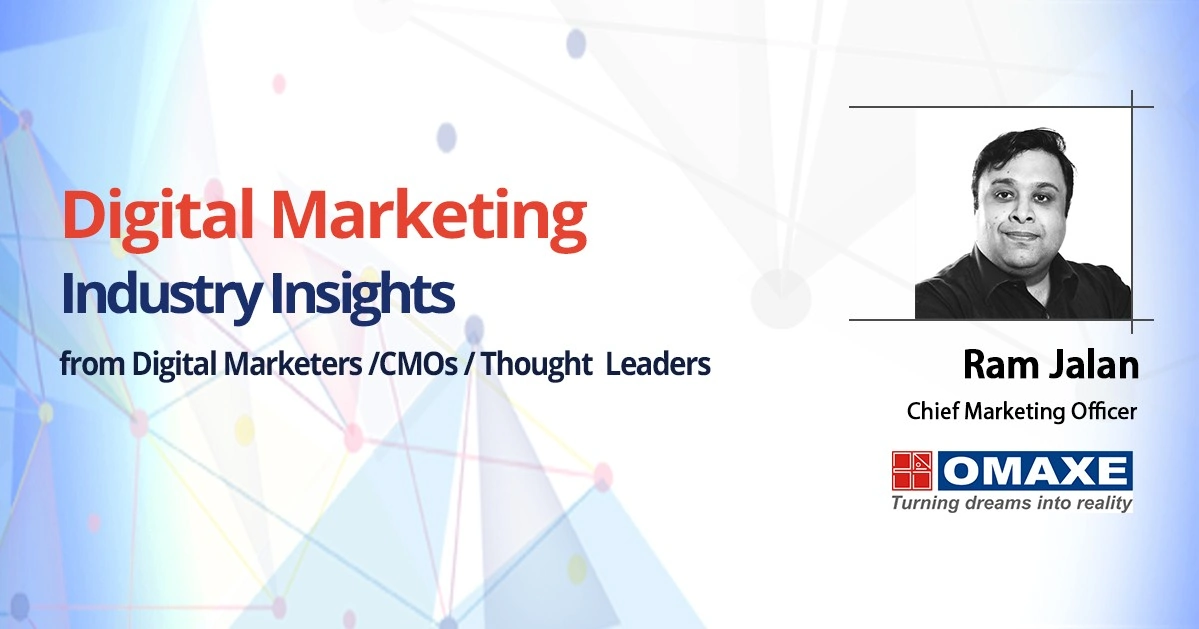Supriya has 15 years of experience across marketing, consulting and human resources, and has worked across the globe in North America, Asia Pacific, India and the Middle East. At InMobi, Supriya leads the North America field marketing team and is also the global product marketing leader for the InMobi Exchange.
A key part of her role is demand generation, a core component of digital marketing, which is deeply entwined with the company’s field marketing efforts. As target audiences spend more time online, it behoves marketers to reach them and speak to them where they are and when they are available.
According to you, what are the advantages of conventional marketing over Digital Marketing? Do you think that Digital Marketing is a threat to the future of conventional marketing?
Supriya Goswami: Digital marketing and conventional marketing is not an either/or proposition. Fundamentally, as a marketer, you will go where your customers and prospects are – if they are spending more time on digital channels (i.e. social, web, apps) you will have to spend more budget on digital marketing efforts.
Think about this stat from eMarketer: “By 2021, the number of “cord-cutters” (consumers shifting their attention to OTT digital video platforms in place of pay TV options) will nearly equal the number of people who have never had pay TV (“cord-nevers”).
Clearly, as a marketer, if your audience is a cord-cutter or a cord-never, you need to shift your marketing tactics as well. At the core, however, the principles and best practices are the same for digital marketing as they are with any other marketing channel.
Marketing has been, and will always be, about ‘connecting’ with your prospects and customers. Depending on the goal this could be an emotional connection or a value-exchange based connect.
In some ways, digital marketing might have an edge, especially when it comes to measurement and the ability to test and make improvements at a far higher pace.
As an example InMobi has been leveraging AI and applying advanced predictive analytics capabilities in the development of mobile ad creatives, to enhance the effectiveness of campaigns. This is done by crunching data on past creatives and campaigns to determine precisely what would work for ongoing efforts.
Share about your 3 favourite Integrated Marketing case studies. What did you like most about them?
Supriya Goswami: The success of a campaign depends on whether the goals of the campaign are met and, unless you are aware of the specific goals, your analysis can be quite superficial. Having said that, I would like to talk about three campaigns, all in very different contexts:
(i) PRODUCT LAUNCH: L’Oreal delivers retail experiences in the palms of consumers – In its 21st Canniversary (Cannes anniversary), L’Oréal launched #SummerEscape, the latest in L’Oreal’s ‘Infallible’ collection with a diverse shade range for Indian skin tones.
Apart from creating awareness among millions about the new collection, L’Oreal India’s core objective was to drive consideration by bringing the retail experience of browsing, testing and trialling directly to the palms of each consumer.
L’Oreal innovated with augmented reality on mobile for consumers to experience the collection. Within a span of 20 days, L’Oreal was able to showcase their #SummerEscape collection to over 700,000 women across a wide variety of cities – from Ahmedabad to Visakhapatnam and from Delhi to Bengaluru – with close to 2.43 million impressions.
The fashion-conscious and fashion-aware female audience loved the immersive experience so much that they spent close to 60 seconds engaging with the ad unit, reaching as high as 90 seconds on weekends. The dwell time was three times higher than the industry standard on rich media ad units.
(ii) CORPORATE SOCIAL RESPONSIBILITY: Diageo battles the menace of drunk driving – Diageo’s McDowell’s No.1 is one of the largest selling spirits brands in the world and India’s largest selling alcoholic beverage brand.
Having always believed in celebrating responsibly, the brand saw a rising and deeply disturbing pattern – drunk-driving. And, they realised that peer pressure was among the biggest factors to drink and drive.
McDowell’s No.1 aimed to not only drive awareness against drunk driving but also enable millennials to #JoinThePact and act responsibly. The brand wanted to strongly influence alcohol consumers at the most critical time to give up the urge of drunk-driving by booking a personal driver.
McDowell’s No.1 tied up with DriveU, leading on-demand driver booking service app, for this campaign. The campaign was able to nudge 3.9 million users across the country, to NOT drink and drive! What’s more, the ad unit saw a total of 296,000 clicks.
The DriveU App alone reached 1.67 million users through the campaign with a CTR of 3.5 per cent and had thus helped many reach safely back home.
(iii) CUSTOMER ACQUISITION: Swiggy employed a data-driven strategy to achieve their user acquisition goals on mobile. Swiggy leveraged advanced targeting such as polygon mapping (location) technology to reach hyperlocal audiences.
Swiggy was able to reach relevant audiences at the right place and the right time. Swiggy achieved its goal of cost-effective acquisition driving 2.6 times the installs (at 2.2 times the spend) with a 17 per cent reduction in CPI. Swiggy saw a 6 per cent decrease in the cost of user acquisition.
According to you, what are the top 3 mistakes committed by organizations today in leveraging Digital Marketing?
Supriya Goswami:
(i) Mistake No 1: Digital and non-digital campaigns don’t speak to each other. Your customers are everywhere and your campaigns should be seamless and interconnected no matter where someone is or how they’re interacting with your brand.
(ii) Mistake No 2: Resorting to popular ‘quick fix’ solutions without really understanding your own context/goals and what your customer needs. Don’t be the selfish person at the party! Listen closely, and then align messaging with what your audience really needs and actually cares about.
(iii) Mistake No 3: Lack of long-term, data-led thinking. Too often, companies develop short campaigns that are not being led by insights. As marketers, it’s easy for our own preconceived notion of what should or shouldn’t work to affect our work. Every audience and campaign is different. Also, since digital is an always-on channel, timed campaigns are not always effective.
Between Agency and In-house, which approach would you recommend for a maximum value of Digital Marketing? Why?
Supriya Goswami: There are a bunch of factors which are critical for the success of a digital marketing campaign:
- Understanding the customer persona
- Being crystal clear about the goal of the campaign (awareness, decision making, advocacy, etc.)
- Crafting the message, content and creatives
- Identification of channels where your customers are and where/how they are engaging with the different channels
- Execution of the campaign (including quick A/B tests to change course if required)
In my experience, while there are some portions of a campaign that can be outsourced, the overall ownership of the campaign success has to be in-house as it is quite hard for any outsourced partner to be an expert on all the points above.
How do you ensure increasing Digital Marketing’s relevance and influence in the organization?
Supriya Goswami: The mantra to increase the relevance/influence of any function in an organization is the same:
- Identify the most pressing problem: Understand the key problem execs/leaders at your company are trying to solve and present succinct analysis on how your proposal helps solve this key problem.
- Start at the top: Find an early adopter and supporter of your cause, ideally at an exec level.
- It’s okay to start small: Don’t be afraid of using wins from small pilots to showcase results.
- Data is your best friend: Wherever possible/necessary, use relevant external data that supports your claims/cause.
- Partner with change champions who are already supporters of your cause.
Eventually, you want to ensure that digital marketing is fully aligned with the needs and goals of the wider organization, and is actively working to support and champion them.
What are the top 3-5 skills you look for when hiring a candidate for Digital Marketing profile?
Supriya Goswami:
(i) Is innovative – i.e. willing to experiment, open to new ideas, proactively searches for new ideas
(ii) Follows a structured problem-solving approach
(iii) Loves analyzing data
(iv) Isn’t overly dependent on specific tools
What is your advice for newbies, who are looking at building a career in the Digital Marketing industry?
Supriya Goswami: Understand the basics, learn to think innovatively and don’t make assumptions. Also, while some tools and tactics come and go, the essence of good marketing remains the same.
How do you stay updated on the latest trends in Digital Marketing? Which are the Digital Marketing resources (i.e. blogs/websites/apps) you visit regularly?
Supriya Goswami: I follow Patrick Mork’s blog very closely. I also refer to the blogs and videos on Neil Patel.com & Moz. MarketingLand and MarketingProfs are good sources of information. I also like to see what competitors and other companies are doing, taking a critical look at their marketing efforts.
How do you see Digital Media evolving in future? What are the top 3 trends do you foresee for 2019?
Supriya Goswami: There are a few trends I see emerging in 2019:
- Merging of advertising and marketing. Both will be increasingly seen as different sides of the same customer acquisition coin.
- Less of a focus on thought leadership and more of a push to establish competitive differentiators.
- A greater focus of marketing efforts on existing customers for retention, as opposed to just a focus on outreach.
Would you like to share a few words about the work we are doing at Digital Vidya?
Supriya Goswami: It is commendable to see how Digital Vidya is enabling digital marketing enthusiasts to build relevant skills. It’s also becoming a curated resource-hub for experienced marketers.
Are you inspired by the opportunity of Digital Marketing? Start your journey by attending our upcoming orientation session on Digital Marketing for Career & Business Growth. It’s online and Free :).



















